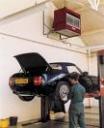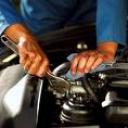August 29th, 2009 by Hal Moses
 Although certified pre-owned warranties are very similar, they do vary some depending on the car manufacturer. They combine the manufacturers original auto warranty with a certified pre-owned auto warranty, and then offer roadside assistance along with other benefits. The advantages are apparent: instead of taking a risk with a used car that you know nothing about, you get a car with a complete history and auto warranty.
Although certified pre-owned warranties are very similar, they do vary some depending on the car manufacturer. They combine the manufacturers original auto warranty with a certified pre-owned auto warranty, and then offer roadside assistance along with other benefits. The advantages are apparent: instead of taking a risk with a used car that you know nothing about, you get a car with a complete history and auto warranty.
Chrysler decided to go one step further and offer extended service contracts for Jeep, Chrysler, and Dodge certified pre-owned vehicles. The contracts will be divided depending on what they cover. For instance, the Lifetime Powertrain Care will cover transmissions, engines, and drivelines; the Lifetime Added Care Plus will cover those mechanisms and also electrical functions in the interior, suspensions, and fuel systems; and the Lifetime Maximum Care plan will cover all of the above with just a few exclusions.
Chrysler has not yet announced pricing plans for these contracts, so it isn’t clear how much more consumers will have to pay to get a lifetime component auto warranty, or whether consumers will want the new car warranties at all.
August 28th, 2009 by Hal Moses
 According to the National Highway Traffic Safety Administration, a recall has been issued by Chrysler for 16,852 Dodge Journeys from 2008-09 model years because of a possible defect in the electrical system of the vehicle.
According to the National Highway Traffic Safety Administration, a recall has been issued by Chrysler for 16,852 Dodge Journeys from 2008-09 model years because of a possible defect in the electrical system of the vehicle.
Dodge Journeys that aren’t equipped with a 115-volt optional auxiliary power outlet have an electrical connector that is unused. The connector could experience corrosion and cause the electrical system to short circuit. However, if the fuse doesn’t happen to blow, there is the potential for the connector to overheat and catch on fire.
To take care of this problem, dealerships will re-route and stow the auxiliary 115-volt power outlet connector and take out the 25-amp fuse so the circuit that is unused doesn’t have any power. To have the problem fixed won’t cost you anything. Car owners can call Chrysler at 1-800-853-1403 or contact the NHTSA Vehicle Safety Hotline at 1-888-327-4236.
Unfortunately, you never know when your car will experience problems, which is why it is important to have used car warranties and a roadside assistance program. These will provide you with peace of mind while you’re on the road.
August 28th, 2009 by Hal Moses
 As soon as GM introduced its marketing campaign saying the Volt will get 230 mpg in the city, the Twitter account for the NissanEV shot back with “Nissan Leaf=367 mpg, not tailpipe, and no gas required. Oh yeah, and it will be affordable, too!â€
As soon as GM introduced its marketing campaign saying the Volt will get 230 mpg in the city, the Twitter account for the NissanEV shot back with “Nissan Leaf=367 mpg, not tailpipe, and no gas required. Oh yeah, and it will be affordable, too!â€
It is important to keep in mind, however, that both of the mileage claims are still up in the air because it is still to be determined how the EPA is going to measure cars like the Volt, that are extended-range electric cars, or cars like the Leaf, that are strictly electric cars that don’t require fuel.
Nissan claims that its 367-mpg figure was determined using the Department of Energy formula, however it is still going to be quite awhile before we know the actual rating, or information about pricing and new car warranties on both the Volt and Leaf.
Nissan may want to fail to mention in it tweets that since the Volt is an extended-range vehicle, it will have the ability to travel a lot farther because of its supplemental gasoline engine. The Leaf is just going to be a city car with limited-range.
August 27th, 2009 by Hal Moses
 Because many people lead busy lives, they try to pick a repair shop that is close to their home. They also try to find a shop that they believe to be trustworthy. Motorists take for granted the freedom of being able to pick where their cars get repaired. This may all be coming to an end.
Because many people lead busy lives, they try to pick a repair shop that is close to their home. They also try to find a shop that they believe to be trustworthy. Motorists take for granted the freedom of being able to pick where their cars get repaired. This may all be coming to an end.
Cars operate through their computers, and it is necessary to have the computer codes to determine if something is faulty on the vehicle. However, car manufacturers often don’t like to release the codes. This means that independently owned repair shops might not be able to properly make repairs. In addition, drivers will be forced to take their vehicles to dealerships. This makes an auto warranty even more necessary for motorists because dealerships tend to charge more for repairs.
There are approximately 220 million cars in the country and only 21,000 vehicle dealerships. Also, there are around 130,000 businesses that make a business of repairing cars. If these businesses don’t have access to computer codes they may eventually go out of business because they won’t be able to perform many repairs on cars.
Congress has recognized this problem and therefore, is trying to pass the Motor Vehicle Owners Right To Repair Act. This bill would make it necessary for car companies to share information with the independent repair shops.
Unfortunately, you never know when your car is going to require repairs, so regardless of where you take your car for service, make sure you have an auto warranty to protect your wallet.
August 26th, 2009 by Hal Moses
 Here’s a question for car shoppers: What has the low sticker price of a pre-owned vehicle with the auto warranty and reliability of a new vehicle? The answer is a certified pre-owned vehicle.
Here’s a question for car shoppers: What has the low sticker price of a pre-owned vehicle with the auto warranty and reliability of a new vehicle? The answer is a certified pre-owned vehicle.
CPO is a term that the auto industry uses to describe used vehicles with low-mileage that are late models. These vehicles have passed a rigorous inspection and therefore have a factory auto warranty to back them up. CPOs are typically in much better shape than a regular used vehicle and come with a regular maintenance schedule that a consumer can verify through Carfax.
Most certified pre-owned programs are offered with an auto warranty, inspection, as well as a return option if you end up not liking the vehicle. However, what consumers end up receiving for the extra money they spend on a CPO car varies a lot. For example, Lexus gives a 100,000 total vehicle; 3 year limited warranty on its COO vehicles. However, Chrysler offers an inspection along with a return policy, yet only offers a 3,000-mile, 3 month limited auto warranty.
Customers need to ensure that they receive an extension of the auto warranty offered by the factory, which will give them the same service of a new car owner.
August 26th, 2009 by Hal Moses
 One way to improve our world would be to alleviate road rage. Everyone has gotten angry with another driver after being cut off. Wouldn’t it be great if we all had cars that helped curb road rage? Well, those vehicles have arrived.
One way to improve our world would be to alleviate road rage. Everyone has gotten angry with another driver after being cut off. Wouldn’t it be great if we all had cars that helped curb road rage? Well, those vehicles have arrived.
Toyota’s RIN has friendliness in mind. It has wide, deep windows that allow the driver to stay connected with the environment. The headlights on the car have controls for light distribution that allow the driver to be considerate to other drivers. It even has features that reflect the psychological state that the driver is in, such as the steering wheel that is “mood trained†and displays that promote the mental health of the driver.
The Toyota i-REAL offers pedestrians added safety. It is a solo transport that offers maneuverability because it sits upright. This allows the driver to be at eye level with pedestrians. Also, it will stretch out its wheels making it more aerodynamic and stable when you want to travel long distances.
The time has come when automakers are realizing that vehicle design can have an impact on how friendly people are. Toyota is making great strides in accommodating fellow drivers and passengers to make our world a friendlier place. Consumers are willing to pay extra money on car costs that will make their lives easier, such as new car warranties, insurance, and even friendlier cars.
August 26th, 2009 by Hal Moses
 There’s nothing worse than planning a trip and waking up to find violent, heavy rains pouring down out of the sky. There are two things you need in this situation, an auto warranty and a reliable car. Do you have a vehicle that is ready for driving in this situation? In this situation it is necessary to have a car that ensures a smooth, safe ride, even in ice and rain.
There’s nothing worse than planning a trip and waking up to find violent, heavy rains pouring down out of the sky. There are two things you need in this situation, an auto warranty and a reliable car. Do you have a vehicle that is ready for driving in this situation? In this situation it is necessary to have a car that ensures a smooth, safe ride, even in ice and rain.
According to the FHWA approximately 6,400,000 cars are involved in accidents every year. About twenty five percent of these accidents are related to weather. Here are some of the best cars to handle in rain.
Although you may not believe it, the Porsche Cayman, as well as the Cayman S are two of the best cars in rain. They are packed with essential all weather features.
For instance, these vehicles have a wiper system with rain sensors that make the wipers activate as soon as water hits the glass. Also, wipers shut off after the car reaches 131 mph.
In addition, these cars have great tire traction, as well as mud guards. They also have the Porsche Stability Management System, which detects when the car is slipping.
Finally, these cars have four-wheel disc brakes that are anti-lock. They are cross-drilled for optimal performance.
August 25th, 2009 by Hal Moses
 Apparently, car thieves aren’t all that concerned about steeling vehicles that are fuel-efficient.
Apparently, car thieves aren’t all that concerned about steeling vehicles that are fuel-efficient.
In fact, SUVs and large pickup trucks are the majority on the top-10 most stolen vehicles list, according to the Highway Loss Data Institute, which is affiliated with the Insurance Institute for Highway Safety.
Number one on the list is the Cadillac Escalade ESV, probably because it is a highly desirable and high profile vehicle. Big time athletes and celebrities drive the Escalade, making it a status symbol. Also, people who drive this vehicle often include options and add-ons that are expensive, such as fancy rims and top-notch stereo equipment. There are 11.3 stolen vehicle claims for the Escalade for every 1,000 vehicles. The average claim is approximately $14,657 loss payment, whereas it is typically $9,396 average for all cars.
According to the Insurance Information Institute, a vehicle is stolen approximately every 24 seconds in America. Just make sure you protect yourself with an auto warranty and a good roadside assistance program.
August 22nd, 2009 by Hal Moses
 For motorists who are sick of paying the high fuel prices and who aren’t willing to wait for carmakers to put affordable electric cars on the market, CNN has reported that auto owners are doing conversions on their gas powered vehicles to make them electric powered.
For motorists who are sick of paying the high fuel prices and who aren’t willing to wait for carmakers to put affordable electric cars on the market, CNN has reported that auto owners are doing conversions on their gas powered vehicles to make them electric powered.
The conversion has been described as “surprisingly easyâ€, which involves taking out the guts of the vehicle, such as the exhaust system and radiator, and making replacements to some, like the fuel injector, with components that are electric. Of course, you could only say this process was “easy†if you regularly do engine swaps. Many motorists don’t even know how to change their oil on their own.
Supporting this industry of do-it-yourself are suppliers that sell the parts necessary to complete the conversion, like Electric Vehicles of America.
Once you do that work, the vehicle should be equipped with lead-acid batteries, since lead-acid batteries remain very expensive at $10,000-$20,000. A truck that is small and has 20 6-volt batteries will reach a speed of 60 mph and run for approximately 40 miles.
Before undertaking a conversion such as this, make sure you know that it will make your auto warranty become null and void. Also, messing with the inner workings of you vehicle can be extremely dangerous if you don’t have any experience.
August 22nd, 2009 by Hal Moses
 Many motorists don’t realize that a little bit of routine maintenance can keep you free of expensive car repairs. And most maintenance takes no more time than refilling the fluid for your windshield wipers. Here are a few tips to help keep drivers safe and free of trouble.
Many motorists don’t realize that a little bit of routine maintenance can keep you free of expensive car repairs. And most maintenance takes no more time than refilling the fluid for your windshield wipers. Here are a few tips to help keep drivers safe and free of trouble.
Make sure to change your oil every 3,000 to 5,000 miles. However, you should check your oil at least once a month. You want the oil line on your dipstick to be between the marker lines. If the oil looks dirty or black, it is time to have it changed.
If you’re having trouble shifting gears you are probably having transmission problems. Check the level of the transmission fluid to determine if it is low. Low transmission fluid could indicate a leak. You should refill it with the lubricant your car recommends. If you see leaking on your driveway take your car to a mechanic.
Also, check your coolant levels. You should have your radiator flushed every two years and change your coolant. In addition, make sure your radiator is corrosion free.
Finally, check your tire pressure every two weeks. Consult your owner’s manual for the correct pressure, and fill your tires accordingly. Remember, both overinflation and underinflation affect safety and fuel efficiency, so it is important to maintain tire pressure.
These simple maintenance tips can keep you from having major, costly repairs. However, it is important to purchase an auto warranty because you don’t want to be faced with unnecessary expenses down the road.
 Although certified pre-owned warranties are very similar, they do vary some depending on the car manufacturer. They combine the manufacturers original auto warranty with a certified pre-owned auto warranty, and then offer roadside assistance along with other benefits. The advantages are apparent: instead of taking a risk with a used car that you know nothing about, you get a car with a complete history and auto warranty.
Although certified pre-owned warranties are very similar, they do vary some depending on the car manufacturer. They combine the manufacturers original auto warranty with a certified pre-owned auto warranty, and then offer roadside assistance along with other benefits. The advantages are apparent: instead of taking a risk with a used car that you know nothing about, you get a car with a complete history and auto warranty.











